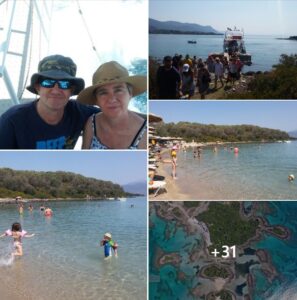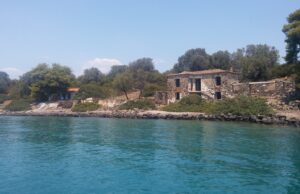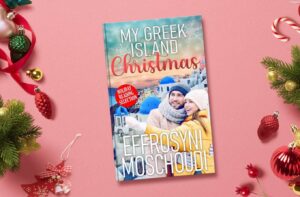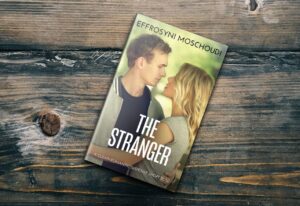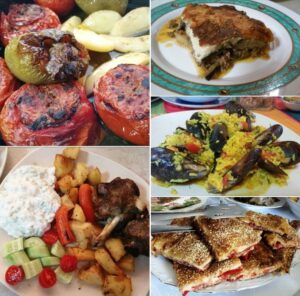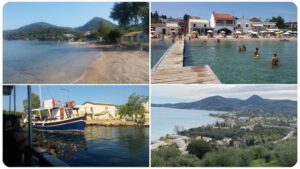SEE THE PHOTOS
The “Seychelles of Greece” delivered the promise
We recently had a day trip to Lichadonissia, a small cluster of volcanic islands between the shores of Kamena Vourla and the northwest tip of the island of Evia.
To get there, we travelled by coach with a local tour operator to the spa town of Kamena Vourla, then hopped onto a taxi boat that took us to Lichadonissia in just a few minutes.
According to Greek mythology, Lichadonissia took their name from Lichas, a man connected to the myth of Hercules.
Hercules’s wife was the jealous type. Thinking he had cheated on her, she sent Lichas to give Hercules a poisonous tunic (chiton) to wear in order to take revenge on him. When Hercules put it on, he suffered terrible pains. Full of rage, he grabbed Lichas and hurled him into the sea, and as his body parts scattered when he hit the water they formed the Lichadonissia. Stroggyli, the distinctive island of the complex that has a round shape, is Lichas’s head according to the legend.
In scientific terms, the story is different, of course. Some 500,000 years ago, a volcanic eruption formed the Lichadonissia, and it is believed that Stroggyli was where the crater used to be. Stroggyli, as its name suggests, has a rounded shape. It is fully covered by vegetation and a lighthouse stands on it, placed there a few decades ago by a French company.
You can see Stroggyli and the other Lichadonissia islands in my photographs. I have included a couple that I found online which show them from high above – truly stunning images that make you want to dive straight in for a swim.
The skipper gave us a wonderful tour, bits of which I will share a little later in this artcle. I’ll just squeeze in here a cool fact that he told us:
Aidipsos (a nearby town in Evia) and Thermopylae (you may know it as the Hot Gates where Leonidas and the 300 fought the Persians) both owe their natural hot springs to the volcanic eruption at Lichadonissia.
He said that the distances from Lichadonissia to these two places are equal. This is a clear indication that it was indeed this volcanic eruption that blessed both Aidipsos and the Hot Gates with this unique therapeutic gift of nature that keeps on giving, hundreds of thousands of years later.
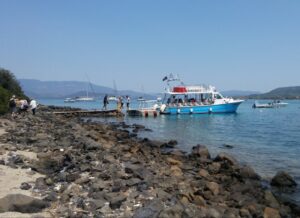
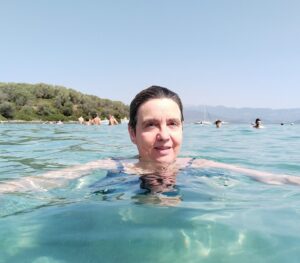
Here I am, trying to show you just how clear the water is in Lichadonissia and probably failing. But perhaps this video will show it more clearly. You’ll also get to hear the sounds of cicadas and the excited squeals of children that complete this idyllic scene of Greek summer bliss.
This video is super-short. Turn up the volume 🙂
The island where we spent two hours swimming and sunbathing is the biggest of the complex and it’s called Monolia. The setting was clearly volcanic, the beach strewn with large volcanic boulders, but in the middle of the bay there was this perfect small stretch of sand. There is a small beach bar and the umbrellas and deckchairs are free. We were made up!
It was just a perfect interval of two hours that ended much too soon. I would have been happy to stay there all day, just swimming and napping.
If you’re interested to go there, you could combine your visit with a stay in the spa seaside town of Kamena Vourla (about 2 hours drive from Athens). Every day, taxi boats go back and forth from there to Lichadonissia.
When we left Monolia beach, the skipper took us around Lichadonissia to show us other locations of interest. The first one was this small settlement on the island of Monolia. Just a few decades ago, some families tried to settle there. They even built a church, Agios Georgios (it’s the smaller building on the left of this photo, half-hidden under the trees).
They tried to sustain themselves in this inhospitable land without electricity or running water. They tried the best they could, including collecting rainwater, but the hardships they faced proved impossible to handle. In the end, just a few years later, they gave up and left. These hollow decrepid buildings stand like vigils on the island still, telling a silent sad story of trial and defeat.
Still, I wasn’t too sad about the people when I found out they hadn’t gone too far. Together with people from other areas of northern Evia, they formed a brand new village that flourished and still thrives today.
I’ll tell you about that village, which I also visited, in a moment. Keep on reading… I have something amazing to show you, which I discovered during the same tour…
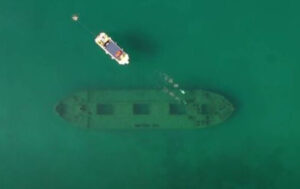
Image credit to ERTNEWS.GR
This is Pioneer I, the fully submerged shipwreck of Lichadonissia – a German boat that was bombed during WWII.
The skipper stopped our boat right above it, and it felt eerie but enthralling too. It looked so white in parts under the crystal clear water, like time had never touched it.
The boat was made of reinforced concrete. This craftmanship for making ships was developed by the Nazis in WWII. Concrete was cheaper than iron and steel, easier to find, and ships could be built a lot faster too.
Pioneer I sunk on july 8, 1944 and lies at a depth of about 10 meters.
It is said that it carried war provisions and guns to supply the islands and also the German troops in North Africa.
Today, the shipwreck has become a magnet to tourists but also other creatures… Would you believe, this place hosts a small population of Monachus Monachus seals (aka monk seals)! The skipper pointed, and we all caught a glimpse of not just one but two seals swimming near the shipwreck. I was so pleased, as I didn’t expect this.
Go here to watch this mesmerising short video I found on Youtube.
You will see the seals, the shipwreck, and the islands from a drone, and also divers going underwater to explore the ship! I loved this video, and I think you’ll love it too. If only for the sunshine and the cute sounds of the seals!
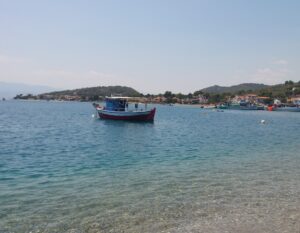
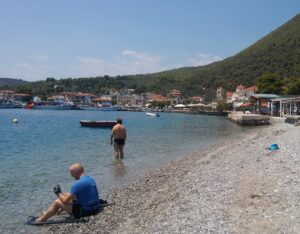
Agios Georgios, a village of avid fishermen!
After our enthralling short cruise around Lichadonissia, we set sail to the northwest tip of Evia. A few minutes later, we entered the harbour of Agios Georgios.
This is the village that was partly founded by the people who had abandoned the small settlement I mentioned earlier. And this time, they picked a spot that guaranteed a more comfortable, prosperous life.
I noted that the village was named after St George, the same saint to whom the people had dedicated the small church at the abandoned settlement.
Agios Georgios is a thriving village today that is sustained mostly by the work of its able fishermen. They are renowned for their catch of local fish, and especially sardines. These able, busy fishermen are well networked, too. Within record times from catching the fish, it arrives to be sold in the central fish markets of Athens!
Agios Georgios is small and idyllic, and seems to be a fantastic place for a quiet beach holiday. It is situated within short distance from other wonderful destinations of Evia, like the spa town of Aidipsos, Istiaia, as well as a bunch of wonderful monasteries too.
There are small hotels on the beach, nothing huge and fancy, which was wonderful to see, and some of the local houses on the seafront are whitewashed and very quaint. I fell in love with a specific corner that looked and even smelled (some herb or flower I guess!) like the lanes at my beloved Messonghi village on Corfu. It made me homesick. I sat on a ledge in the shade to take in the atmosphere for a while and didn’t want to leave ha ha
We ate in the highly recommended taverna Antonis, a couple minutes walk from the port, that offered anything the heart could possibly desire. Meats, fish, seafood, and cooked meals too. Everything we sampled was delicious. But, before we ate, we made sure to have a little dip in the sea first, just outside the taverna.
The water looked inviting and the shingles on the shore made that irresistible sound that reels me right in. It was around 2 o’clock, very hot, and we were famished by then, so we didn’t stay long, but that swim will stay indellible in my mind forever.
It was the perfect beach for me, not just because I love beaches with shingles (the sound of seawater rushing through the shingles is one of my favourite sounds in the whole world!) but also because the water became deep quickly. We don’t often get to swim in beaches like this. It was a true gem, and if I ever get the chance to return there for a day or two I’ll go running. If only, to try some more of that fresh sardine!
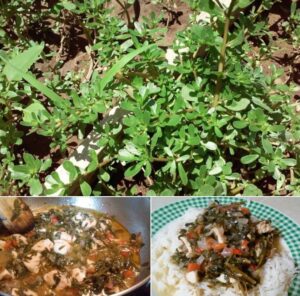
Purslane is too good to give to the pigs!
An American friend told me once they call purslane ‘pigweed’ in their neck of the woods. Not sure if this is true in other parts of the States as I’ve seen pictures of other weeds online that are called pigweed too.
In any case, I expect purslane is eaten by pigs. I know chickens love it. But, if you have animals, and love to recycle your weeds by throwing it to them, do think twice! Like in the case of dandelion, that I know rabbits love to eat for example, purslane is packed with nutrients too precious to miss out on!
First off, it has the highest levels of omega-3 fatty acids of any land-based plant. The omega-3 fatty acids keep the arteries healthy and thus help prevent strokes, heart attacks, and other forms of heart disease. Purslane also contains nutrients that protect from cancer and also benefit the bones and the liver. It contains many vitamins and important minerals like calcium and magnesium. It even helps the overweight and obese to lose weight! I mean, it is a precious gift of nature that, unlike medicine and supplements, is perfectly safe, without any side effects, costs nothing, and is waiting for you, right now, in your garden!
I love to eat it raw in a salad with tomato and cucumber. For the dressing, I use salt, olive oil and a generous amount of red wine vinegar.
I cook it too, in a recipe with chicken that I partucularly enjoy all summer when the front patch of my garden is full of purslane.
As I stated earlier, I love it raw. Purslane is succulent and fresh with a wonderful texture and taste, but when cooked, it acquires a totally different tang that’s all the money!
GO HERE to see my recipe and learn more. Enjoy!
OOPPAAA! SIGN UP TO MY BIMONTHLY NEWSLETTER AND GET 3 BOOKS FROM ME AS A WELCOME GIFT! SEE BELOW FOR THIS OFFER!
YOU KNOW WHAT THEY SAY… SHARING IS CARING! Tweet this to spread some love:
Interested in travel, food and books from Greece? Here's a blog you will love! #Greek #blogger #writer Share on X
3 FREE books for you! Sign up below to receive them instantly!
NEW! Clean Christmas romance. Single mother Cathy Roussos gave up on love long ago, and veterinarian Alex Rallis doesn’t believe in it, but one magical Christmas on a Santorini farm might just change everything…
Check it out on Amazon Read a FREE sample!
A clean romantic suspense short read with an unreliable narrator that’ll keep you guessing! Vera is losing her mind over famous actor Yannnis Ksenos, except, she isn’t just a fan… Now, she plucks up the courage to ring his doorbell… Visit Amazon

